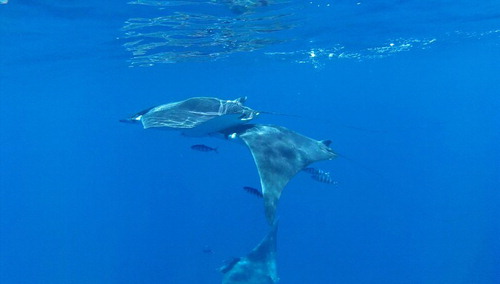ABSTRACT
Courtship behaviour of the giant devil ray Mobula mobular is described from northern New Zealand, temperate southwest Pacific Ocean, for the first time. A mating train consisting of a full-term pregnant female and up to four males was observed over a period of 147 minutes. Their behaviour was similar to courtship behaviour observed in other large mobulids. Biting of the female was not observed, possibly due to the female’s use of the surface to prevent males positioning themselves above her. However, the lead male pressed the female’s abdomen and underside each time the female reached or stopped at the surface. The occurrence of pregnant females and mating behaviour off northern North Island confirms breeding occurs in New Zealand waters.
Introduction
Knowledge of the reproductive behaviour of elasmobranchs has become increasingly important as more species are threatened by fisheries, pollution and habitat loss (Pratt & Carrier Citation2001; Dulvy et al. Citation2014a). However, the inherent difficulty of observing free-living elasmobranchs means that their reproductive behaviour has generally been inferred from post-mortem examination of reproductive structures and genetics, supplemented by occasional direct observations of mating in captivity and the wild (Notarbartolo di Sciara Citation1988; Pratt & Carrier Citation2001).
Manta and devil rays (Mobulidae) are circum-globally distributed in tropical and warm temperate regions (Couturier et al. Citation2012). As currently recognised, the family consists of at least eight species, including two (Mobula alfredi, M. birostris) that were formerly placed in the genus Manta (Notarbartolo di Sciara Citation1987; Marshall et al. Citation2009; Poortvliet et al. Citation2015; Bustamante et al. Citation2016; Hinojosa-Alvarez et al. Citation2016; White et al. Citation2017). Mobulids are economically valuable as ecotourism species, and are also taken in directed fisheries and as by-catch (Couturier et al. Citation2012). Their resilience to fishing is low due to their very low population growth rate, and the International Union for Conservation of Nature (IUCN) Red List of Threatened Species lists M. alfredi and M. birostris as Vulnerable to Extinction; the Atlantic and Mediterranean population of M. mobular as Endangered; the Indo-Pacific population of M. mobular (formerly M. japanica), M. munkiana and M. thurstoni as Near Threatened; and M. hypostoma, M. kuhlii and M. tarapacana as Data Deficient (Couturier et al. Citation2012; Dulvy et al. Citation2014a, Citation2014b). Direct observations of mating behaviour in free-living batoids, particularly mobulids, are relatively rare (Tricas Citation1980; Pratt & Carrier Citation2001; Couturier et al. Citation2012). Mating behaviour has been documented in the manta rays (M. alfredi, M. birostris) but not for most of the smaller devil rays (Yano et al. Citation1999; Marshall & Bennett Citation2010; Couturier et al. Citation2012; Deakos Citation2012). The exceptions are Coles’ (Citation1910) detailed description of copulation in M. hypostoma (as M. olfersi) from the western North Atlantic, and Sobral’s (Citation2013) brief description of a M. tarapacana ‘mating train’ at the Azores.
During the austral summer M. mobular is relatively common off the northeast North Island, New Zealand, where they are taken as by-catch in the skipjack tuna (Katsuwonus pelamis) purse seine fishery (Paulin et al. Citation1982; Duffy & Abbott Citation2003; Francis & Jones Citation2017). Little is known of the species’ biology in the southwest Pacific and, despite occasional captures of pregnant females, reproduction in New Zealand waters has not been confirmed. In March 2017 one of us (SCT) encountered and filmed several small groups of M. mobular about 10.4 km northeast of Poor Knights Islands, New Zealand. At least one of these groups was a mating train consisting of a focal female pursued by several males. The behaviour of these rays is described below. To the best of our knowledge this is the first description of courtship in M. mobular and the strongest evidence to date of reproduction by this species in New Zealand waters.
Methods
The rays were observed from a 10.7 m launch. Underwater images were obtained using a HD digital video camera (GoPro Hero 5 Black, GoPro Inc.; Contour 1700, Contour LLC) attached to a camera pole. Conditions were clear and sunny. Beaufort Sea State (SS) was 2 (estimated wind speed 5 kn NE) when the rays were first sighted and eased to SS 0 for most of the observation period, but increased to SS 3 (estimated wind speed 10 kn NE) around 1500 h. Water depth (165 m) and sea surface temperature (21.8 °C) were measured by the vessel’s depth sounder. Underwater visibility was about 20 m. Disc width (DW) of the rays was visually estimated using the launch for scale.
Results and discussion
Two groups of devil rays were observed splashing at the surface at 35°22.063′S, 174°48.028′E (WGS84), at 1230 h on 4 March 2017. Observation of the rays ceased at 1515 h. The maximum displacement from the original sighting was about 70 m southwest (at 35°22.1′S, 174°48′E). There was no discernible change in the rays’ behaviour throughout the observation period, and they appeared to ignore the presence of the vessel, often swimming close to the hull and passing underneath it. Thirty-two minutes of underwater video of the rays was obtained in 39 sequences varying in length from 8 s to 218 s. All of the rays were identified as Mobula mobular based upon the following diagnostic characters: subterminal mouth; upper disc grey with a bluish sheen anteriorly, and a conspicuous dark collar extending between the spiracles; dorsal fin with a white tip; underside white; spiracle above the pectoral fin origin; short spine at the base of the tail immediately posterior to dorsal fin; and long whip-like tail ().
Figure 1. Male giant devil rays (Mobula mobular), northeast North Island, New Zealand, 4 March 2017. Diagnostic characters are: white tipped dorsal fin; spine at base of tail; dark collar extending between spiracles; spiracle located above the pectoral fin origin; and long, whip-like tail. The claspers of the lead male are visible protruding past the posterior margin of the pelvic fins.
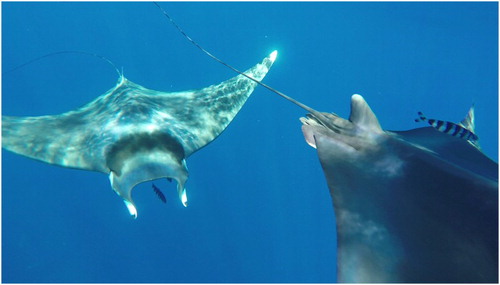
The first group encountered consisted of three individuals between c. 2.0–2.5 m DW. These rays alternated between swimming in single file with the largest in the lead, and one swimming beside the largest with the third following them. They swam rapidly in straight lines but changed direction frequently. A single 10 s video sequence was obtained of this group swimming in single file. Their sex could not be determined but the lead ray appeared to have a distended abdomen.
The second group consisted of a large individual c. 3 m DW pursued by four others (see https://www.youtube.com/watch?v=gd8feQv_Ewg). The individuals closest to the lead ray were 2.5–2.8 m DW, and were followed by two 1.8–2.0 m DW individuals. The video imagery showed the lead ray was a female that appeared close to full-term pregnancy (). All the pursuing individuals were judged to be mature males based upon the size of their claspers after Marshall & Bennett (Citation2010) (). No clasper scarring was observed, suggesting that none of the males had mated recently (Marshall & Bennett Citation2010). Throughout the observation period the female swam ahead of the pursuing males, making frequent, rapid changes in direction including banking steeply and swimming in inverted loops (). The female also occasionally stopped suddenly forcing the following males to overshoot and circle back. From time to time the female would stop swimming at or just below the surface. When this occurred, the closest male would approach the female from below and press his cephalic fins and the top of his head against the underside of her body, frequently her abdomen (). When this happened the female would pause briefly before accelerating away, or turn and swim in the opposite direction. On three occasions a male swam upward beneath the female, once on the female’s right side and twice on the left, tilted its body and appeared to try and grasp the female’s pectoral fin (). No other attempts to bite the female were observed. No mating scars were observed on the female’s pectoral fins. No aggression was observed between the pursuing males; however, the two largest were always the closest to the female. On one occasion the second male in the train swam in front of the leading male which then dropped back into second place without any reaction. During periods of contact between the leading male and female the second male in the train would circle them, sometimes joined by one or both of the smaller males. At other times the small males would circle below the rays at the surface, rising rapidly to rejoin the train as soon as the female moved off.
Figure 2. A near full-term pregnancy giant devil ray (Mobula mobular) (right) swimming on a parallel course past two pursuing males (left) after having made a rapid 180° change in direction; northeast North Island, New Zealand, 4 March 2017.
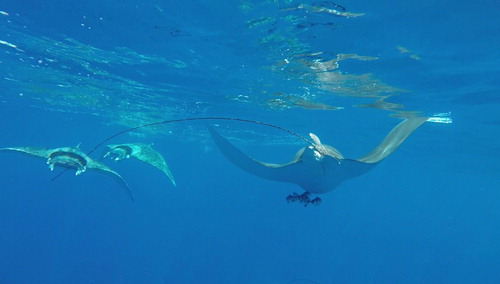
Figure 3. Pregnant giant devil ray (Mobula mobular) swimming in a tight circle with three pursuing males.
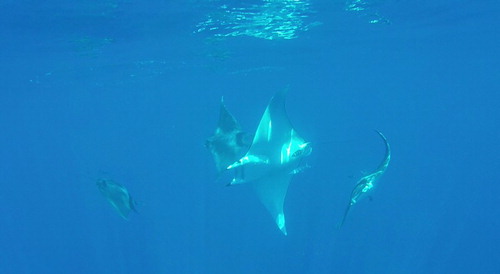
Figure 5. Possible attempt by a male giant devil ray (Mobula mobular) to grasp the left pectoral fin tip of the female.
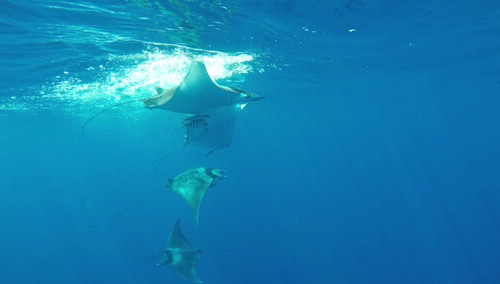
At 1431 h contact with the rays was lost for about 30 min. Between 1452 h and 1456 h three brief sequences were obtained of two devil rays, one swimming behind the wing tip of the other. These rays kept their distance from the boat and their sex could not be determined. The largest had a white marking on the dorsal surface of the right pectoral fin, just behind the anterior margin about halfway between its origin and the tip. As none of the rays observed prior to this had any distinctive markings it is likely that this pair represented a third group. Contact with the second group was re-established at 1502 h. When observations ceased at 1515 h the female descended in a spiralling motion pursued by all four males. Another group of rays, possibly the first group, was still visible on the surface nearby.
Courtship behaviour of Mobula mobular appears to be similar to that of M. alfredi, M. birostris and M. tarapacana. Behavioural components of courtship common to all four species are prolonged close pursuit of females by multiple males (mating trains), and female avoidance involving faster than usual swimming speeds and veering, circling and looping behaviour (Yano et al. Citation1999; Marshall & Bennett Citation2010; Deakos Citation2012; Sobral Citation2013). Copulation in M. alfredi and M. birostris follows the male grasping the female’s pectoral fin tip, almost always the left, with its mouth and positioning itself abdomen-to-abdomen with the female (Yano et al. Citation1999; Marshall & Bennett Citation2010). While pursuing the female, males typically position themselves close to the female’s dorsal surface prior to attempting to grasp the female’s pectoral fin (Yano et al. Citation1999; Marshall & Bennett Citation2010; Sobral Citation2013). We did not observe this behaviour, possibly due to the female’s tendency to swim at, or close to, the surface (Pratt & Carrier Citation2001). The three potential attempts to bite the female’s pectoral fin followed approaches from below (e.g. ). Copulation also occurs abdomen-to-abdomen in M. hypostoma but Coles (Citation1910) reported the male was positioned above the female with its pectoral fins raised above its back, while the female firmly grasped the male with its pectoral fins.
Mating in elasmobranchs appears to be mediated by olfactory cues (Tricas Citation1980; Pratt & Carrier Citation2001; Chapman et al. Citation2003). Observations of male Mobula alfredi pursuing select females, including pregnant ones, while ignoring other adult females in the area suggests that they use chemical cues to distinguish reproductively receptive females (Marshall & Bennett Citation2010; Deakos Citation2012). Although Deakos (Citation2012) observed several M. alfredi mating trains he did not observe physical contact between males and females. In contrast, our observations of male M. mobular pushing against the female’s underside and cloaca are very similar to observations of courtship behaviour in Myliobatis californica (Feder et al. Citation1974; Tricas Citation1980).
Reproductive periodicity is variable in elasmobranchs, with mating inferred to occur soon after parturition in some species, while others may have a resting period between pregnancies (Pratt & Carrier Citation2001; Marshall & Bennett Citation2010; Deakos Citation2012). Our observations indicate that female M. mobular are likely to mate soon after parturition. Direct observation of post-partum mating in batoids is limited to Chapman et al.’s (Citation2003) observation that free-living male Hypanus americanus were strongly attracted to pens holding females that had just given birth, and immediately mated with the females when placed in the pen with them. Notarbartolo di Sciara (Citation1988) concluded that M. mobular inhabiting the Gulf of California mate during late spring and early summer based on clasper condition and the presence of semen in claspers. Our observations indicate that mating occurs in autumn in the Southern Hemisphere. White et al. (Citation2006) reported neonates from Indonesia in April and May suggesting that the timing of parturition and mating may be similar across the southwest Pacific.
Mobula mobular appear to migrate seasonally to the waters off northern New Zealand, with peak abundance occurring during summer and early autumn (Duffy & Abbott Citation2003; Francis & Jones Citation2017). Detailed reproductive data are not available for New Zealand waters, but pregnant rays, embryos up to 85 cm DW and free-living juveniles as small as 1 m DW have been taken off the northeast North Island (Paulin et al. Citation1982; Stewart Citation2002). White et al. (Citation2006) reported neonates of 92 cm and 99.4 cm DW, suggesting it is possible that the smallest juveniles seen by Paulin et al. (Citation1982) were born in New Zealand waters. Our observation of a mating train involving an apparently full-term pregnancy ray confirms M. mobular reproduces off northern North Island. Further research is required to determine if breeding occurs every year in New Zealand waters, and what proportion of the population gives birth here.
Acknowledgements
We thank the reviewers of this paper for their suggestions and constructive criticism.
Disclosure statement
No potential conflict of interest was reported by the authors.
References
- Bustamante C, Barría C, Vargas-Caro C, Ovenden JR, Bennett MB. 2016. The phylogenetic position of the giant devil ray Mobula mobular (Bonnaterre, 1788) (Myliobatiformes, Myliobatidae) inferred from the mitochondrial genome. Mitochondrial DNA Part A. 27(5):3540–3541. doi: 10.3109/19401736.2015.1074208
- Chapman DD, Corcoran MJ, Harvey GM, Malan S, Shivji MS. 2003. Mating behavior of southern stingrays, Dasyatis americana (Dasyatidae). Environmental Biology of Fishes. 68:241–245. doi: 10.1023/A:1027332113894
- Coles RJ. 1910. Observations on the habits and distribution of certain fishes taken on the coast of North Carolina. Bulletin of the American Museum of Natural History. 28:337–348.
- Couturier LIE, Marshall AD, Jaine FRA, Kashiwagi T, Pierce SJ, Townsend KA, Weeks SJ, Bennett MB, Richardson AJ. 2012. Biology, ecology and conservation of the Mobulidae. Journal of Fish Biology. 80:1075–1119. doi: 10.1111/j.1095-8649.2012.03264.x
- Deakos MH. 2012. The reproductive ecology of resident manta rays (Manta alfredi) off Maui, Hawaii, with an emphasis on body size. Environmental Biology of Fishes. 94:443–456. doi: 10.1007/s10641-011-9953-5
- Duffy CAJ, Abbott D. 2003. Sightings of mobulid rays from northern New Zealand, with confirmation of the occurrence of Manta birostris in New Zealand waters. New Zealand Journal of Marine and Freshwater Research. 37:715–721. doi: 10.1080/00288330.2003.9517201
- Dulvy NK, Fowler SL, Musick JA, Cavanagh RD, Kyne PM, Harrison LR, Carlson JK, Davidson LNK, Fordham SV, Francis MP, et al. 2014a. Extinction risk and conservation of the world’s sharks and rays. eLife. 3:e00590. doi:10.7554/eLife.00590.
- Dulvy NK, Pardo SA, Simpfendorfer CA, Carlson JK. 2014b. Diagnosing the dangerous demography of manta rays using life history theory. PeerJ. 2:e400. doi:10.7717/peerj.400.
- Feder HM, Turner CH, Limbaugh C. 1974. Observation on fishes associated with kelp beds in Southern California. California Department of Fish and Game, Fish Bulletin 160. 144 pp.
- Francis MP, Jones EG. 2017. Movement, depth distribution and survival of spinetail devilrays (Mobula japanica) tagged and released from purse-seine catches in New Zealand. Aquatic Conservation: Marine and Freshwater Ecosystems. 27:219–236. doi: 10.1002/aqc.2641
- Hinojosa-Alvarez S, Walter RP, Diaz-Jaimes P, Galván-Magaña F, Paig-Tran EM. 2016. A potential third manta ray species near the Yucatán Peninsula? Evidence for a recently diverged and novel genetic Manta group from the Gulf of Mexico. PeerJ. 4:e2586. doi:10.7717/peerj.2586.
- Marshall AD, Bennett MB. 2010. Reproductive ecology of the reef manta ray Manta alfredi in southern Mozambique. Journal of Fish Biology. 77:169–190. doi: 10.1111/j.1095-8649.2010.02669.x
- Marshall AD, Compagno LJV, Bennett MB. 2009. Redescription of genus Manta with resurrection of Manta alfredi (Krefft, 1868) (Chondrichthyes, Myliobatoidei, Mobulidae). Zootaxa. 2301:1–28.
- Notarbartolo di Sciara G. 1987. A revisionary study of the genus Mobula Rafinesque, 1810 (Chondrichthyes, Mobulidae), with the description of a new species. Zoological Journal of the Linnean Society. 91:1–91. doi: 10.1111/j.1096-3642.1987.tb01723.x
- Notarbartolo di Sciara G. 1988. Natural history of the rays of the genus Mobula in the Gulf of California. Fishery Bulletin. 86:45–66
- Paulin CD, Habib G, Carey CL, Swanson PM, Voss GJ. 1982. New records of Mobula japanica and Masturus lanceolatus, and further records of Luvaris imperialis (Pisces: Mobulidae, Molidae, Louvaridae) from New Zealand. New Zealand Journal of Marine and Freshwater Research. 16:11–17. doi: 10.1080/00288330.1982.9515943
- Poortvliet M, Olsen JL, Croll DA, Bernardi G, Newton K, Kollias S, O’Sullivan J, Fernando D, Stevens G, Galván-Magaña F, et al. 2015. A dated molecular phylogeny of manta and devil rays (Mobulidae) based on mitogenome and nuclear sequences. Molecular Phylogenetics and Evolution. 83:72–85. doi: 10.1016/j.ympev.2014.10.012
- Pratt HL, Carrier JC. 2001. A review of elasmobranch reproductive behavior with a case study on the nurse shark, Ginglymostoma cirratum. Environmental Biology of Fishes. 60:157–188. doi: 10.1023/A:1007656126281
- Sobral AFL. 2013. Biology, ecology and conservation of mobulid rays in the Azores [Unpublished M.Sc. thesis]. Department of Oceanography and Fisheries, University of the Azores. 78 pp
- Stewart A. 2002. Mantas and devil rays. Seafood New Zealand. 10(3):65–68.
- Tricas TC. 1980. Courtship and mating-related behaviors in myliobatid rays. Copeia. 1980(3):553–556. doi: 10.2307/1444540
- White WT, Corrigan S, Yang L, Henderson AC, Bazinet AL, Swofford DL, Naylor GJP. 2017. Phylogeny of the manta and devilrays (Chondrichthyes: Mobulidae), with an updated taxonomic arrangement for the family. Zoological Journal of the Linnean Society. 20:1–26.
- White WT, Giles J, Dharmadi PI. 2006. Data on the bycatch fishery and reproductive biology of mobulid rays (Myliobatiformes) in Indonesia. Fisheries Research. 82:65–73. doi: 10.1016/j.fishres.2006.08.008
- Yano K, Sato F, Takahashi T. 1999. Observations of mating behavior of the manta ray, Manta birostris, at the Ogasawara Islands, Japan. Ichthyological Research. 46:289–296. doi: 10.1007/BF02678515

